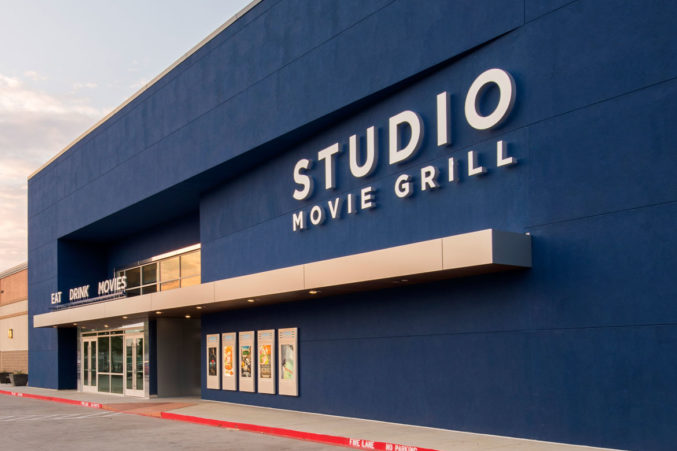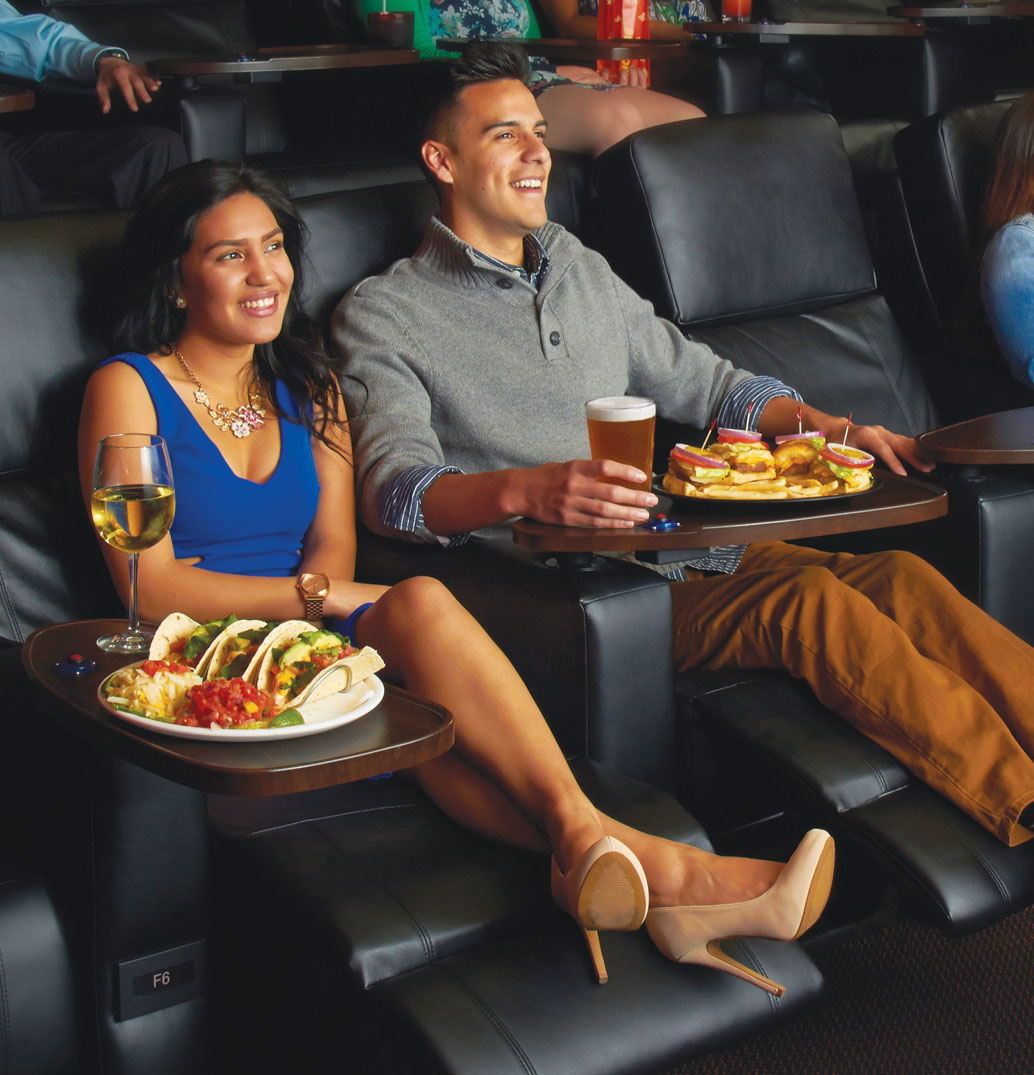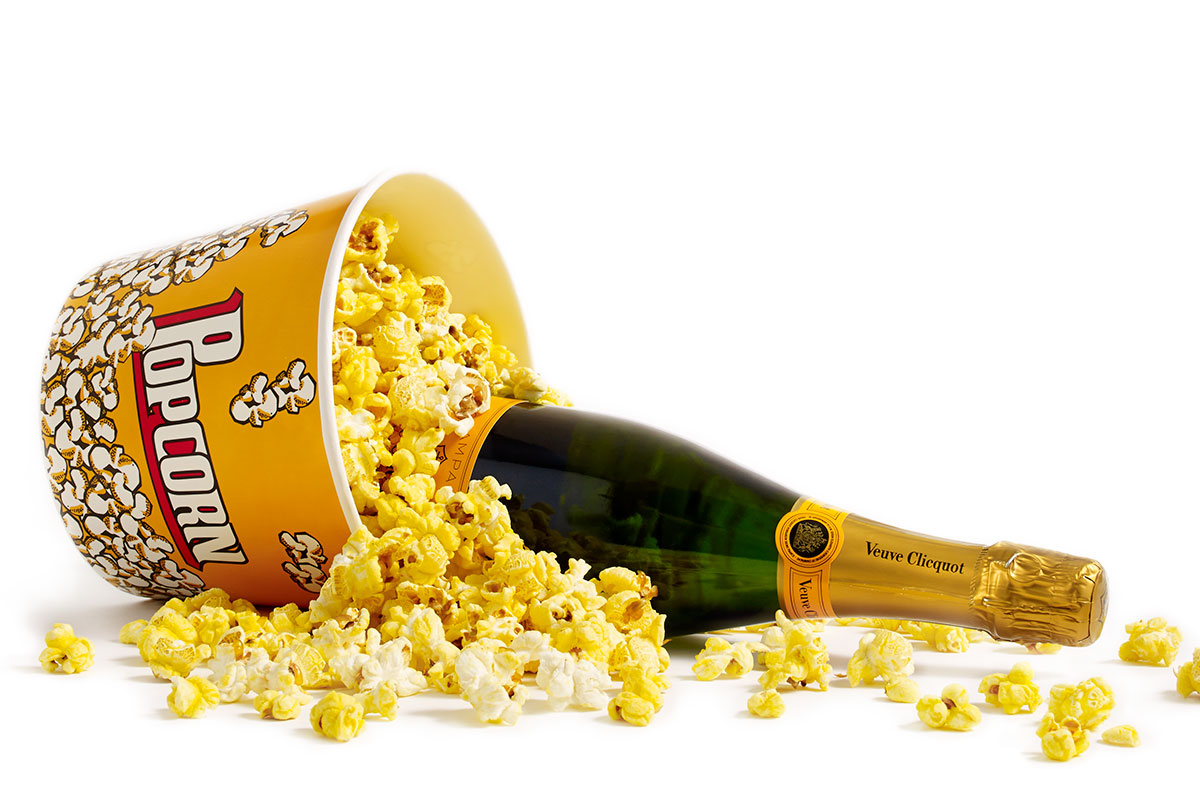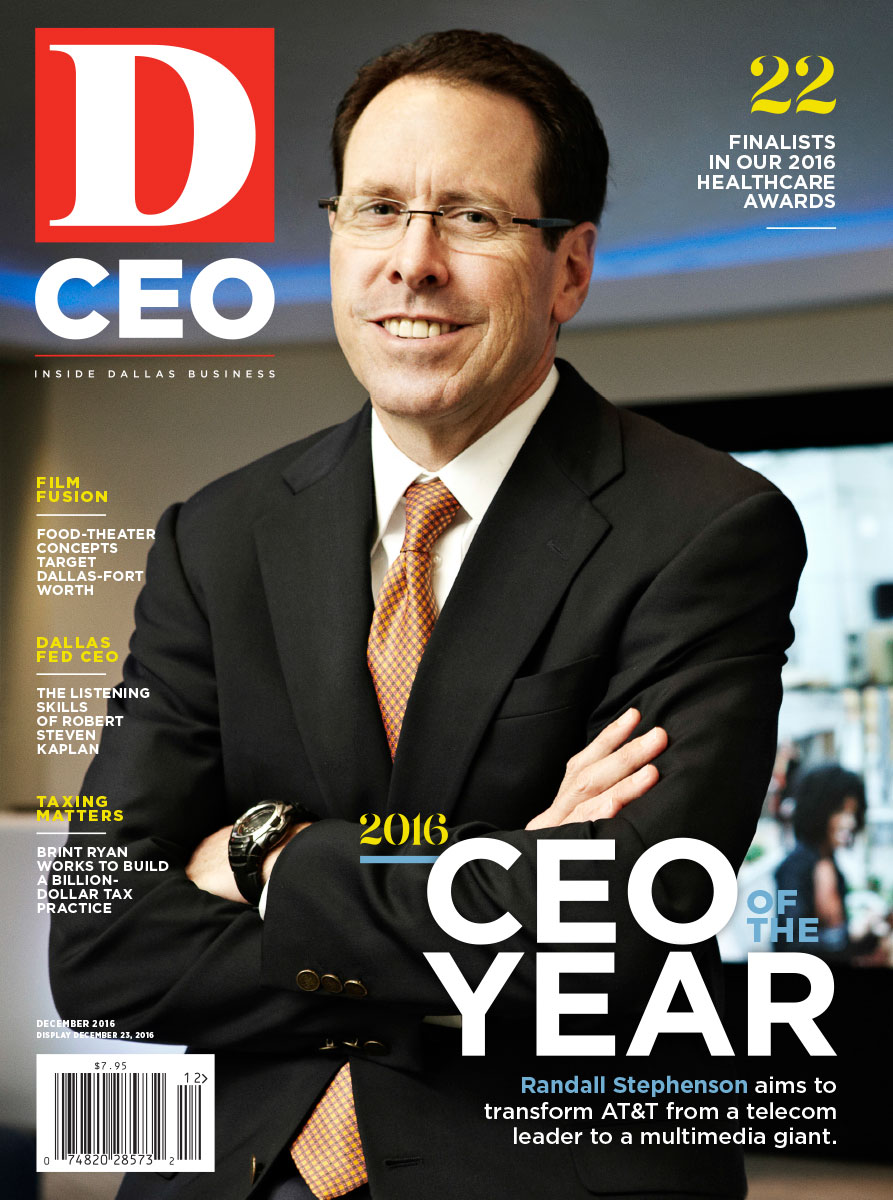In 1992, Brian Schultz chanced upon a historic, one-screen theater in Bethesda, Md. The place was dingy and served frozen food, but Schultz saw something special. “It reminded me of a family dining café,” recalls Schultz, who’s now CEO of Dallas-based Studio Movie Grill. “You were seated next to folks you didn’t know. It was love at first sight. An epiphany.”
 Seven years later, Schultz launched his first Studio Movie Grill in Addison. The venture’s concept was, and remains, simple: dinner and a movie. The menu is diverse, offering a wide range of crowd-pleasing entrées, like smoked ribs with coleslaw and build-your-own pizzas, mostly in the $9 to $15 price range. Desserts include traditional theater popcorn and a selection of boxed candy, alongside more decadent options, like Nutella beignets. There’s also a generous offering of cocktails, “adult” shakes, margaritas, and daily drink specials. The menu is made-to-order, and the seats are plush and comfortable—a far cry from the impersonal, stripped-down type you might find at an aging megaplex.
Seven years later, Schultz launched his first Studio Movie Grill in Addison. The venture’s concept was, and remains, simple: dinner and a movie. The menu is diverse, offering a wide range of crowd-pleasing entrées, like smoked ribs with coleslaw and build-your-own pizzas, mostly in the $9 to $15 price range. Desserts include traditional theater popcorn and a selection of boxed candy, alongside more decadent options, like Nutella beignets. There’s also a generous offering of cocktails, “adult” shakes, margaritas, and daily drink specials. The menu is made-to-order, and the seats are plush and comfortable—a far cry from the impersonal, stripped-down type you might find at an aging megaplex.
The food and seats weren’t enough, though. Early on, Studio Movie Grill couldn’t compete directly with big-name goliaths like Cinemark and AMC. Schultz’ concept was a novelty, relegated to showing “sub-run” movies (or films that already had been shown by larger theaters). So Schultz pursued anyone on his radar who might be able to help him win first-run rights. Eventually, he pestered a contact at Disney until the man granted Schultz the rights to one movie—with the caveat that, once his theater-restaurant concept failed, Schultz would never bother the guy again. That movie was “The Waterboy,” and its debut at SMG was successful enough to grab other studios’ attention. Almost overnight, Studio Movie Grill established itself as a “real” movie theater—helping pave the way for other theaters to progress, and providing consumers with more movie-watching options.
Pioneering SMG is one of the most successful examples of a growing trend that boasts strong Texas ties: an attack on the traditional cinema by a variety of newer, trendier, theater-restaurant fusion concepts. There’s Austin-based Alamo Drafthouse Cinema, known for its humorous, no-texting PSAs and special events—like showing an old movie on 35mm film, or inviting attendees to dress in costume. There’s Mark Cuban’s and Todd Wagner’s Los Angeles-based Landmark theaters, which combine the cocktails of your neighborhood bar with the comfort of your living room couch. There’s also Dallas-based Movie Tavern, which touts a breakfast menu during early weekend showings, as well as LOOK Cinema, a sleek, futuristic, local theater that offers dining options from IVY Kitchen, a gourmet standalone restaurant.
 “These offerings are becoming the mainstream,” says Jeff Bock, senior box office analyst at the entertainment research firm Exhibitor Relations in Los Angeles. “We’re seeing these upscale movie theaters that are basically drafthouses, but with a lot more money put into them. Right now, that’s what’s holding the industry together.”
“These offerings are becoming the mainstream,” says Jeff Bock, senior box office analyst at the entertainment research firm Exhibitor Relations in Los Angeles. “We’re seeing these upscale movie theaters that are basically drafthouses, but with a lot more money put into them. Right now, that’s what’s holding the industry together.”
Steve Stodghill, a Dallas lawyer who’s been involved with the film industry for years, says North Texas has been a fulcrum point in the popularity of high-end theaters. “Dallas is a very hot city, from an economic standpoint,” he says. “There’s a lot of cash to spend. Folks are looking to have a better overall experience. That’s why the dine-in experience with food and beverage offerings is doing so well.”
A Way to ‘Get Out’
The American film industry has been battling new, disruptive forms of entertainment for decades. But the modern landscape is different. A barrage of high-budget TV shows like “Game of Thrones” and “House of Cards” snaps up busy consumers’ limited screen-watching time. Video streaming services like Netflix, Amazon Prime, and Hulu allow people to catch a flick in their living rooms or bedrooms, no box office (or gas or parking) required.
Still, though, people enjoy going out to the theater—provided there’s a host of special features and dining options to choose from. Schultz says that his company has grown at a rate of 20 percent for the past four years, with annual revenue that’s now north of $200 million. There are 24 Studio Movie Grill locations in 10 states, and things don’t seem to be slowing—even with the rise of Netflix. In fact, Schultz considers the streaming service an ally.
“These offerings are becoming the mainstream. Right now that’s what’s holding the industry together.”
Jeff Bock, Exhibitor Relations
“There are different occasions for different experiences,” Schultz says. “I know Netflix is put up as a huge competitor, but I think it helps create movie lovers. To me, that’s a positive for the entire creative community and industry.”
Bill DiGaetano, COO of Alamo Drafthouse DFW, agrees. “You can watch a baseball or basketball team on TV, but people still buy tickets to see it live,” DiGaetano says. “Humans have to get out, and theaters are one of the least expensive options. And since our content changes, it’s always new.”
Alamo Drafthouse, founded by Tim League in Austin in 1997, brings a little edge to the dine-in movie experience, catering strongly to cinephiles with a sense of humor. Alamo has a full listing of $6 to $11 snacks, including fried pickles, wings, roasted garlic hummus, and of course, popcorn—with “real clarified butter” upon request. They also offer brunch options (like the $9 caramel crème brulee French toast), hearty burgers, Hatch green chile mac and cheese, pizzas, and veggie-filled salad wraps. There’s a big selection of beer, and the cocktails are rated—G means no booze, R means plenty of it.
 “More and more people are understanding the brand,” DiGaetano says. “People ask: ‘Are you guys like Studio Movie Grill, or Movie Tavern?’ But that’s like comparing the Bee Gees to Led Zeppelin—and, in that example, I like to think of us as Led Zeppelin.”
“More and more people are understanding the brand,” DiGaetano says. “People ask: ‘Are you guys like Studio Movie Grill, or Movie Tavern?’ But that’s like comparing the Bee Gees to Led Zeppelin—and, in that example, I like to think of us as Led Zeppelin.”
Alamo Drafthouse has expanded across the country with both company-owned and franchised locations, including four theaters in North Texas. The company plans to open additional theaters in the Dallas area, and new markets include Los Angeles and Corpus Christi. Over the last five years, Alamo has enjoyed an annual growth rate of 28 percent, and last year recorded more than $140 million in sales.
“We don’t sit around and talk about who we need to become to attract millenials or the over-50 crowd,” DiGaetano says. “We want people to come out for the experiece.”
Rivals Jump In
The success of Alamo and SMG has spawned a number of different approaches to the same basic concept. Movie Tavern—founded in 2001 in Dallas and acquired in 2013 by New Orleans-based VSS-Southern Theaters—offers throwback movie screenings, food like the $11.95 Thanksgiving Refrigerator Sandwich or $16.95 Game Day Platter (bacon cheese fries with wings and sliders), and the option to buy a $12 refillable beer mug.
“People ask: ‘Are you guys like [SMG], or Movie Tavern?’ But that’s like comparing the Bee Gees to Led Zeppelin.”
Bill DiGaetano, Alamo Drafthouse DFW
Austin-based Moviehouse & Eatery, which has three locations in North Texas and one in Austin, offers half-price tickets on “Deal Days,” plus a menu full of not just good food, but local beer, wine, and custom cocktails. Leslie Sloan, co-owner and managing partner of Moviehouse & Eatery, says time is another factor contributing to the rise of the dine-in theater like Moviehouse. “During the week, there’s not time to have dinner, move locations, and go to a movie,” Sloan says. “In a shorter window, you can accomplish both. It’s a time-saver for busy families.”
The Moviehouse menu is dietary restriction-friendly, with icons indicating food suitable for vegetarians, vegans, and those with gluten sensitivities. The food options are gourmet but accessible, like the veggie supreme pizza (made with pumpkin seed pesto) and carnitas steet tacos (pork tacos with pickled shallots and cilantro). Sloan says the company’s current gross annual revenue is $32 million—and projects that the 2017 figure will be somewhere around $45 million.
LOOK Cinemas (it has a single location, in Dallas) is a bit more chic, with adult-only screens near the bar, an in-theatre call-button service, and the option of a power recliner or living room-style armchair. The IVY Kitchen there serves upscale, slightly pricier fare—think $13 flatbreads and entrees including a $29 filet mignon and $18 jumbo fried shrimp—to moviegoers who’ve opted for the so-called LOOK AND DINE experience.
Together with lawyer Steve Stodghill, principal attorney at Dallas law firm Fish & Richardson, LOOK played a key role in making smaller theaters more competitive with the industry giants. Stodghill, who may be DFW’s most intense film fanatic, has been vice chair of the American Film Institute’s national council since 2012. The internet is littered with photos of him surrounded by movie stars and Hollywood power players, and his IMDB lists a handful of acting and producing credits. Through the Fish firm, Stodghill became involved in a first-run rights case that helped change the landscape for small cinemas.
In 2014, AMC built a theater less than a mile from LOOK. Under pressure from AMC, film distributors agreed to give the new AMC theater location exclusivity, denying LOOK the opportunity to show certain blockbusters. LOOK took its anti-competitive concerns to Stodghill’s firm, which launched a media campaign against AMC. Soon the Department of Justice and Texas Attorney General opened investigations and, by 2016, four major Hollywood studios had agreed to no longer honor “clearance requests”—meaning the smaller theaters can more easily compete with the big guys.
Giants Battle Back
The big theaters know that some people will always prefer the traditional extra-large-screen experience. So to keep up with the smaller cinemas, the big chains are changing, too. Some now offer select theaters with full menus, waiters, and bar service. Some have replaced their ripped-up chairs with nice recliners, and their dingy box office areas with hotel-like lobbies.
 Cinépolis USA, which recently moved its headquarters to Addison, is the American branch of Morelia, Mexico-based Cinépolis, the fourth-largest movie theater in the world, with screens in 13 different countries. CEO Adrian Mijares Elizondo says the company plans to expand at a rate of five new theaters per year. The chain offers three tiers of theater experiences: luxury (leather recliners and a full-service dining experience), premium (improved concession menu), and traditional (exactly what you’d expect).
Cinépolis USA, which recently moved its headquarters to Addison, is the American branch of Morelia, Mexico-based Cinépolis, the fourth-largest movie theater in the world, with screens in 13 different countries. CEO Adrian Mijares Elizondo says the company plans to expand at a rate of five new theaters per year. The chain offers three tiers of theater experiences: luxury (leather recliners and a full-service dining experience), premium (improved concession menu), and traditional (exactly what you’d expect).
“We’re not just competing against other movie theaters. We’re competing against all of the entertainment options that guests have,” Elizondo says. “With our luxury dining concept, we’re always looking to offer our guests more.”
Cinépolis is not the only big theater that’s evolving. Other large cinema corporations have realized that they’re not the only seats in town, too. Leawood, Kan.-based AMC now offers a selection of dine-in movie theaters, with names like “Fork & Screen,” “AMC Red Kitchen,” and “Cinema Suites.” In 2014, The Wall Street Journal reported that the company had begun a $600 million campaign to exchange its old seating for plush recliners—and that movie attendance had increased an average of 80 percent in the renovated theaters.
Carmike Cinemas of Columbus, Ga., offers a 100-item menu in select theaters, with plans to expand. In recent years, Plano-based Cinemark introduced a self-serve concession stand, where you can pick up a margarita or latte, and even butter your popcorn. The company also has a “Movie Bistro” available in a few locations, offering a standard-fare menu (reasonably priced pizza, sandwiches, and tacos) that’s available for delivery in the auditorium.
Besides introducing new dining options, big chains have the clout to invest in the latest technologies. XD, 3D, and IMAX screens are not only too expensive for consumers to replicate, but smaller theaters often don’t have the money or space to install them, either. “Premium is the top of the market at the moment, but the multiplex is still mainstream,” says David Hancock, head of film and cinema at IHS Technology. “Not all cinemas are becoming premium, but now there’s a lot more choices—whether it’s comfy seats, 4D, laser screens, or dining options.”
Movie theaters have always made most of their money in concessions—and now, with entrée options, cocktails, and kids’ menus, they’ve got a host of new ways to collect revenue. This explains why theaters remain lucrative, even as overall attendance has dropped. Sales at Cinemark, for example, fell by a reported 2 percent in the final period of 2014; even during a year of historically low box office revenue, however, profits generated from Cinemark’s concession stands grew by 6.5 percent. According to Nasdaq, Cinemark’s earnings were $216.8 million in 2015, up from $192.6 million in 2014.
 Time will tell whether the big theaters, new and improved with plush seating and gourmet menus, will displace the smaller cinemas on which their new upgrades are based. “It’s a gambler’s marketplace,” says Bock, the box office analyst with Exhibitor Relations. “It’s $100 for four people to go to the movies, and that’s too expensive for most people these days. Theaters target the 30 percent who have discretionary cash and don’t mind spending a little more of it. The movie might not be the best part of your evening, but theaters want to make sure the premiums are.”
Time will tell whether the big theaters, new and improved with plush seating and gourmet menus, will displace the smaller cinemas on which their new upgrades are based. “It’s a gambler’s marketplace,” says Bock, the box office analyst with Exhibitor Relations. “It’s $100 for four people to go to the movies, and that’s too expensive for most people these days. Theaters target the 30 percent who have discretionary cash and don’t mind spending a little more of it. The movie might not be the best part of your evening, but theaters want to make sure the premiums are.”
That’s the way Schultz from Studio Movie Grill sees it, too. “The days of going to the theater and the days of it being a commodity because it’s the only entertainment option, are gone,” he says. “Now, it’s about how to create an experience that’s compelling enough, and provides the right value equation, so that guests really want to have the experience, versus on their phone, or on the couch—or not at all.”






